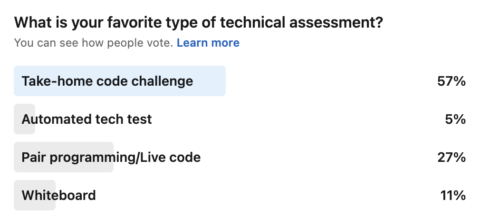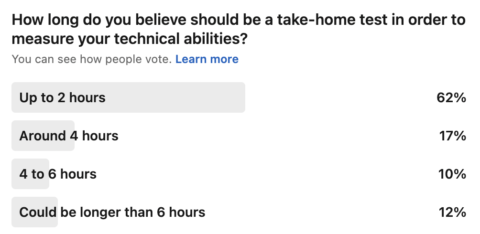Technical Assessment, Coding Challenge, Case Study, Take-Home Test. Almost every modern hiring process requires some form of (more or less practical) work sample from its applicants. When done right, these tests provide confirmation of the candidate’s ability and “hard skills” to succeed in the role.
But it’s no news that these tests are a much-disputed topic, especially when it comes to tech talent. While some companies are confident about their lengthy hiring process, developers often feel these are not compatible with having a full-time job and a personal life. They refuse to proceed with application processes that include long technical assessments.
It’s a fine balance between gathering the information you need for your hiring decision and to not turn off your best candidates. Luckily, there are many ways to evaluate technical expertise in an effective AND engaging way.
Your technical assessment can boost, or decay your reputation, and developers will spread the word. A great tech assessment will result in more qualified inbound applications and an increased response rate to your outbound recruiting.
Top 5 Mistakes When Designing a Technical Assessment
A good take-home offers several advantages over other technical tests but it’s easy for companies to screw it up. The biggest mistakes companies usually make are:
- Not involving team members when building the test.
- Choosing a format that doesn’t suit your candidate “audience”.
- Expecting candidates to complete extended take-home tests.
- Sharing a test that has zero relation to the actual work, lacks clarity and doesn’t get people excited.
- Providing poor feedback or none at all.
So how can you convert your engineering technical assessment into a reputation booster?
1. Put yourself on the map with a technical assessment that is worth people’s time
A genuine and well-designed hiring process puts you on the map for great talent. From an HR perspective, the best way to start is to involve the hiring team’s members early in the process. While they should validate the need for the role and review the job description, also involve them in the design of the technical assessment. All too often, a hiring manager comes up with a coding challenge, without engineers actually testing it. While you rely on the hiring team’s expertise, provide them with guidelines. All engineers in the team should actually go through your tech challenge and validate relevance and achievability. They should look out for tech stack relevance, complexity, time to complete and similarity to their real work. Ideally, you provide them with a feedback form or scorecard to evaluate.

By involving the team, you will more likely evolve your tech challenge consistently and organically excel in your candidate experience. Most importantly, you will increase your referrals. When an engineer is proud of the technical hiring process that they have built, they’ll become an in-house ambassador who talks about it.
In conversations with engineers in our network, we often hear about technical tests they enjoyed doing or helped build. A developer at Mattermost, a 200 people open source platform, proudly shared how they handle tech tests.
“At Mattermost they test your technical abilities by asking you to solve an issue on their repository. This is really exciting for engineers because they get the chance to see and work on real code. They assign candidates with a mentor to guide them and answer questions when needed. This is actually not a short test, but you have the chance to do a draft PR to explain more later. Once the test is over, they pay candidates money for the time invested 🙂 “
An interesting fact is that most of our examples were given by candidates that weren’t selected for the job but still have a good memory of the process and spoke well about the company.
On another occasion, an engineer who participated in a hiring process at Preply explained he received a Take-home test to be done in React with Components and an API. He highlighted how clear and right to the point the test was. In the end, he wasn’t hired but what he appreciated was the speed and the detailed feedback and suggestions they gave him.
2. & 3. Select the right format, and keep it short
There are several perspectives on what makes a great technical challenge. But when actually asking candidates, take-home tests are still the favourite assessment of 57% of engineers. They prefer this over pair programming/live coding challenges (27%). The least favourite formats in our Linkedin poll were automated tech tests and whiteboard exercises.

But not all take homes are created equal. 62% of candidates believe that a take-home shouldn’t take longer than two hours. Anything longer, and you’ll risk them to drop out of the interview process. On the other hand, almost 40% believe that a take-home can be four hours or longer. This means, if your assessment is this long, you can expect two-thirds of candidates to either drop out or not even enter/apply.

A great example of a company with a balance between time and format is Netlify. An engineer within our network said that the technical test doesn’t last more than 2 hours. It’s actually a “live test”, but you are on your own. They create a Slack channel with engineers that will be available for you to ask questions on the day of the test. They invite you to join on a specific date & time and you are free to communicate in the chat as much as you need. If you don’t finish they tell you that is also fine. In the next call, you will discuss the implementation.
This setup takes out the pressure of having everyone on a call looking at your work. The amount of time invested seems doable on a normal day and they provide live feedback. They really seem to know the importance of providing a safe space to ask questions while being thoughtful of both the candidate’s and the internal team’s time.
4. Create A Reputation With Relevant, Exciting Work
To create a reputation with your technical test and still get a good measure of candidates’ abilities, follow these three principles:
- Choose a work-related project: The closer the project is to real work, the better the impression of how the candidate will contribute to the business. At the same time, this will give candidates an idea of what they will be doing when they join your company. This will help them better assess the opportunity and avoid making the wrong decision. Down the line, you’ll also benefit from fewer hires quitting early on.
- Set clear expectations: Ask candidates to focus on shipping features that serve your business objectives. Explain what you want to see in the test. You’ll still see the difference between the person that fits and who doesn’t. For example, if a good README section is important to you, be clear about this and don’t wait for candidates to prioritize it on their own. Another one: You have preferences with specific tech stacks candidates should use. Then state them clearly. Candidates with more solid experience will excel, while others don’t get away with their lack of knowledge. Clarity about expectations will reduce the time to complete and still showcase the candidate’s ways of working.
- Define communication flow: All companies work in different ways and people should not be expected to “know” everything. Provide the right set-up so the candidate can feel comfortable to ask questions or comment doubts before going forward with the test.
5. Give Back And Be Thoughtful Of People’s Time
Giving feedback is no longer an alternative. You not only have to provide feedback after a technical test but you also have to do it right. Yes, it can be time-consuming, but so is completing your test. If you’ve decided not to move forward with a candidate you still have to make this encounter worth their time. Also it is important to make it a learning experience. That’s how they will remember you (or not). If you provide thoughtful feedback it will have repercussions. A much used, but still great, quote fits perfectly here: “I’ve learned that people will forget what you said, people will forget what you did, but people will never forget how you made them feel.” – Maya Angelou
Final advice to make the most out of your technical assessments
We’ve asked Tech Leads about their preferences and perceptions on how to best evaluate technical abilities. Tiago, Tech Lead of a 200 people UK-based travel scale-up, said to us: “The code test is not by any means the best metric to validate a candidate’s real potential or capacity, but without it, you’re hiring blind and taking massive risks with false positives.” On the other hand, Jesper, CTO of a start-up based in Rotterdam, doesn’t rely on tech tests to evaluate technical abilities. He said: ”… The people we hire usually have a track record that sort of speaks for itself (or a public GitHub profile I can nose around in). I don’t really focus on the tech side so much in the interview (apart from actual experience of course), but I try to gauge their willingness to learn and how quickly they can adapt to things…”
As we can see, there are several perspectives and alternatives to assess technical abilities. As a tech leader or TA Manager, you should listen to what engineers have to say and work on a process that represents the team and increase the chances of getting the best people on board.
You need to keep in mind that most candidates are mostly passive. This means they are not actively looking for a job and they have a busy agenda between work and personal life. We recommend you reduce the time to complete your technical test as much as possible (better to focus on soft skills and motivations that will have a broader impact in the long term). Not only for candidates but for the sake of your own team, interviewing can be exhausting. Restricting the time for test revision, and structuring feedback with a shorter test will help your team feel less pressured.

During uncertain times, people are more likely to resent new job offers and will avoid time-consuming technical tests. Meanwhile, while layoffs and economic slowdowns may make some good talent available, there is obviously not enough for all the companies that are still hiring.
There are many companies delivering an excellent candidate experience. You can also check out how top tech companies interview technical talent to get inspired.
If you have already integrated the mantras of a good hiring process we are pretty sure you are ready to take your Take-home test to the next level.
At acework, we specialize in simplifying global recruitment for businesses. Our extensive candidate pool, proven hiring playbook, and experienced team of senior talent partners all over the world allow organizations to expand their talent pools and tap into a diverse and global workforce faster.
Our strategic advisory services enable organizations to gain deep insight into the talent landscape and develop sustainable recruitment plans that drive action. We manage the entire sourcing and outreach process, providing invaluable feedback, market insights, and a compelling employer value proposition to attract top talent.
Whether you’re building a remote-first or hybrid team or seeking talent for your local hub, acework is your trusted recruitment and talent acquisition partner.







